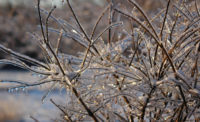Cold stress: Protecting workers in refrigeration environments

Credit: sorn340 / iStock / Getty Images Plus
Working in refrigerated environments is difficult. To cope, many workers adopt a posture of bravado that might be risky in the long run. Mind over matter — more precisely, if you don’t mind, it doesn’t matter — works only so long when exposed to extreme cold.
After that, workers run the risk of cold stress, which is essentially a drop in core temperature occurring when the body loses heat faster than producing it. Consequences range from poor work performance to serious, long-lasting health implications and even death.
That’s why it’s imperative that those working with industrial freezers are able to recognize, treat, and most important prevent cold stress and its potential health impacts.
Risk factors in refrigerated environments
The likelihood of cold stress is increased when certain risk factors are present. These include:
- Improper clothing
- Wetness or dampness
- Physical exhaustion, generally poor physical condition, or preexisting health issues such as hypertension, hyperthyroidism, or diabetes
Cold stress induced maladies to watch for
The most common cold stress related health issues are hypothermia, frostbite, trench foot, and chilblains. Here are their symptoms and treatment strategies:
Hypothermia: Though typically occurring at extremely cold temperatures, hypothermia, wherein body temperature drops below 95 degrees Fahrenheit, can occur at temperatures above 40 F if a person is chilled from sweat or other moisture. Mild symptoms include shivering, but in severe cases shivering will stop and the afflicted may lose coordination, become disoriented, or lose consciousness. Potentially fatal, steps to treat hypothermia include:
- Move the person to a warm room.
- Replace wet clothes with dry clothes and cover the body with blankets.
- Place warm water bottles or hot backs around the person’s core (in armpits, at the sides or the chest, and around the groin).
- If the person is unconscious, call 911.
- If the person isn’t breathing, perform CPR until they respond or medical assistance arrives.
Frostbite: Freezing of the skin and the tissues beneath, frostbite typically impacts fingers, toes, hands, and feet. Amputation can result from severe cases. Symptoms include numbness, tingling, and waxy or blistered skin. To treat, follow the steps for hypothermia. Don’t rub, massage, or otherwise directly contact the impacted skin as this may cause more damage to the frozen tissue.
Trench foot: Also known as immersion foot, trench foot results from the constriction of blood vessels to the feet as a reaction to prolonged exposure to wet and cold conditions. Symptoms include cramping, swelling, numbing, blistering, or redness. Treatment options include:
- Remove wet shoes and socks.
- Gently dry the feet.
- Call 911.
If possible, do not walk on afflicted feet to avoid further damage.
Chilblains: Repeated exposure to temperatures just above freezing can cause the painful inflammation of small blood vessels in the skin known as chilblains. Chilblains typically presents as inflamed swelling or blisters on the hands and feet, which sometimes appear hours after being in the cold. To ease the symptoms, keep the skin warm and dry. Typically not resulting in permanent injury, chilblains usually resolves in two to three weeks.
Prevention is the key
Common sense measures are the best way to avoid cold stress.
Foremost is employee training and education. Employees must be informed on the dangers of cold stress, its signs, and remedies. Employers should underscore that the company prioritizes safe practices by making scheduling, staffing, and equipment maintenance decisions that reflect as much.
Employers must encourage safe work practices. Working in cold environments can cause dehydration, so warm, sweetened liquids and the time to consume them should be provided. Frequent breaks in warm areas should be scheduled or at the very least encouraged. Rotating workers and assigning work in teams wherever possible allows coworkers to keep an eye on each other. New workers and those coming back after an absence should be allowed to build up a tolerance to the environment by easing into the work with shorter stints at first.
Dressing for the job is essential. Layering with loose-fitting clothing is recommended. Moisture-wicking material (wool, silk, and synthetics) next to the body, an insulation layer, and a ventilated but moisture resistant outer later are recommended. Hats or hoods stop heat from escaping through the scalp. A knit mask or gator to cover the face to the nose, insulated and water-resistant gloves, and insulated, nonskid boots should all be considered.
Warm up to safety
A warm jacket and a tough attitude are not enough to ward off cold stress in highly refrigerated work environments. An approach that encompasses education, awareness, and planning will keep workers safe and employers better able to show compliance and avoid liability. A healthy workforce is a more productive one.
Sources
https://www.allegrosafety.com/cold-stress-prevention-keeping-workers-warm-and-safe/
https://www.osha.gov/emergency-preparedness/guides/cold-stress
Looking for a reprint of this article?
From high-res PDFs to custom plaques, order your copy today!








